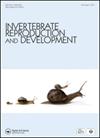Mating strategies of the endangered insular land crab Johngarthia lagostoma (H. Milne Edwards, 1837)
IF 0.8
4区 生物学
Q4 REPRODUCTIVE BIOLOGY
引用次数: 4
Abstract
ABSTRACT Hard-shell-mating is the typical way that semi-terrestrial and terrestrial crabs copulate, when females reproduce with a hard carapace during the intermoult period and the couples have a brief or absent pre- and post-copulatory behaviour. For Gecarcinidae crabs there are few studies on reproductive behaviour, and are especially rare for isolated species, as in the genus Johngarthia. Here, we describe the mating behaviour of the endangered insular crab J. lagostoma endemic of the South Atlantic Ocean, with a focus on pre-, copulatory, and post-copulatory behaviours. Observations were made on 20 pairs in the field, with every female in intermoult. Accessory behaviours were absent, with copulation beginning after sexual recognition. After mating, there were no records of males guarding or embracing females. All couples had the female in an upper position and passive males, which do not react when other males are near the mating site. The size of the chelipeds and males were random and not determinant to mating. However, yellow crabs predominated (95%) in mating pairs and the linkage of colouration to sexual selection needs to be more elucidated because purple crabs are less frequent in the population and the lower representation in the couples can be an effect of this. Experimental studies are required to investigate sexual selection and the occurrence of the behaviour described herein at other locations.濒临灭绝的岛屿陆蟹Johngarthia lagostoma的交配策略(H.Milne Edwards,1837)
摘要硬壳交配是半陆生和陆生螃蟹交配的典型方式,雌性螃蟹在交配间隙用硬壳繁殖,配偶在交配前后有短暂或缺失的行为。对于Gecarcinidae螃蟹来说,很少有关于繁殖行为的研究,对于孤立物种来说尤其罕见,比如Johngarthia属。在这里,我们描述了南大西洋特有的濒危岛蟹J.lagostoma的交配行为,重点是交配前、交配后和交配后的行为。在野外对20对雌蛛进行了观察,每对雌蛛都在山间。附属行为不存在,交配在性识别后开始。交配后,没有雄性守护或拥抱雌性的记录。所有的伴侣都让雌性处于上位,而雄性处于被动,当其他雄性靠近交配地点时,它们不会做出反应。螯肢和雄性的大小是随机的,并不是交配的决定因素。然而,黄蟹在交配配对中占主导地位(95%),颜色与性选择的联系需要进一步阐明,因为紫蟹在种群中的频率较低,而在配对中的代表性较低可能是其影响。需要进行实验研究来调查性选择和本文所述行为在其他地方的发生。
本文章由计算机程序翻译,如有差异,请以英文原文为准。
求助全文
约1分钟内获得全文
求助全文
来源期刊
CiteScore
1.90
自引率
0.00%
发文量
21
审稿时长
>12 weeks
期刊介绍:
Invertebrate Reproduction & Development ( IRD) presents original research on the reproductive and developmental biology of the Invertebrata, both embryonic and postembryonic. IRD welcomes papers reporting significant results obtained using new techniques. Encouraged topic areas include: aquaculture, physiology, biochemistry, functional morphology, phylogeny, behavioural and regulatory mechanisms, including genetic, endocrine and molecular studies. Papers containing qualitative descriptions of reproductive cycles and gametogenesis will not be considered. IRD is published in association with the International Society of Invertebrate Reproduction and Development.

 求助内容:
求助内容: 应助结果提醒方式:
应助结果提醒方式:


